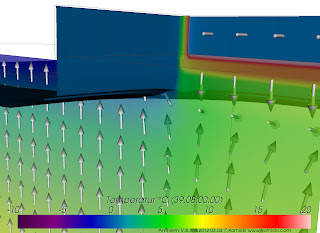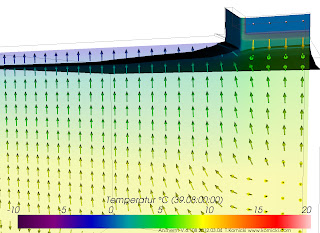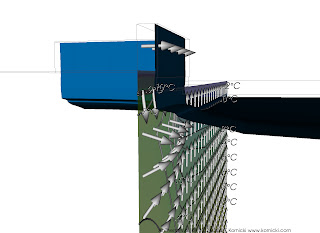Why you should model and calculate in 3D - a publication by Dr. Pont:
The consideration of thermal bridges in building envelopes gained
importance in recent years. This is due to their potential impact on the
overall thermal building performance of highly-insulated buildings.
Moreover, energy-efficient buildings tend to be more sensitive to
problems associated with thermal bridges, such as surface condensation,
mould growth, and thermal comfort issues. Therefore, planners must
minimize the negative impact of thermal bridges. Although user-friendly
thermal bridge simulation tools are available, they are not yet widely
used in practice. Instead, planners often rely on generic details from
the building construction literature. The thermal performance of such
details often remains unknown, given the wide range of possible building
materials (and their thermal properties). In this contribution, we
present the results of a thermal bridge simulation of a set of such
standard details. Thereby, we assessed vertical sections through typical
constructions via 2D thermal bridge simulation, as well as 3D corner
situations constituted by such 2D sections. This was done to address two
research questions: i. How do typical details perform, given the large
range of thermal properties of applied materials? ii. How does the
performance of the 3D-thermal bridges compare to their constituent
2D-details, and is it possible to use 2D results to approximate the
results of 3D thermal bridges?
Link to the publication: http://www.antherm.at/antherm/C75_postreview.pdf
Monday, 16 October 2017
Wednesday, 22 March 2017
3D DXF Import
The latest Version of AnTherm is able to import 3D models from AutoCAD, ArchiCAD, Revit and similar programs.
Tuesday, 17 January 2017
AnTherm Version 8.132
The latest version of AnTherm is version 8.132. In this version, we implemented a new DXF import functionality. Now closed polylines can be imported even if they are not axis-parallel. With this, AnTherm also supports elements with slopes and roundings.
The new functionality "Surface Temperatures" allows the user to display a graphic with the surface temperatures of a room.
Now it is also possible to make several screen-captures in the Results 3D Window and use them in the reports generator.
Psi evaluations (for 2D projects) are possible from the program and from the Results 3D Window.
The new functionality "Surface Temperatures" allows the user to display a graphic with the surface temperatures of a room.
Now it is also possible to make several screen-captures in the Results 3D Window and use them in the reports generator.
Psi evaluations (for 2D projects) are possible from the program and from the Results 3D Window.
Labels:
2d,
3D,
aktualisierung,
AutoCAD,
DXF,
Feuchte,
fRsi,
moisture,
Roundness,
Rundung,
Schräge,
Slope,
U value,
U-Wert,
Wärmebrücke,
Wärmebrückenberechnung,
Ψ-Wert
Tuesday, 5 April 2016
AnTherm Documentation Update
The software AnTherm is equipped with extensive Help and Documentation. AnTherm-Blog offers supplemental information. Picture gallery (Picasa) and Video gallery (YouTube) provide visual impression.
This documentation is not only included with the program's installation but it can be also viewed on internet.
We've made efforts to provide documentation suitable for every user - an engineer, architect or student - making the starting the use of an application as easy as possible. Theoretical background of building physics and engineering calculations, used algorithms and procedures but also normative information have found their way into the documentation.
Extensive tutorials enable an easy start for new user leading him through a calculation of a two dimensional and then three dimensional thermal bridge component. The study of examples provides a quick overview of major application's functions. We've selected few common construction components for chosen simulations and thermal heat/cold bridge analyses. Evaluations of heat stream (heat flux) lines, temperature on component's surfaces or throughout an interior of construction or even evaluations of condensing humidity (dew point) to answer the question about the risk of mould growth have been considered in examples chosen.
This documentation is not only included with the program's installation but it can be also viewed on internet.
We've made efforts to provide documentation suitable for every user - an engineer, architect or student - making the starting the use of an application as easy as possible. Theoretical background of building physics and engineering calculations, used algorithms and procedures but also normative information have found their way into the documentation.
Extensive tutorials enable an easy start for new user leading him through a calculation of a two dimensional and then three dimensional thermal bridge component. The study of examples provides a quick overview of major application's functions. We've selected few common construction components for chosen simulations and thermal heat/cold bridge analyses. Evaluations of heat stream (heat flux) lines, temperature on component's surfaces or throughout an interior of construction or even evaluations of condensing humidity (dew point) to answer the question about the risk of mould growth have been considered in examples chosen.
- Complete application's documentation (HTML, requires HTML-Help navigation component and JavaScript within your browser)
- Complete application's documentation (HTML, without navigational elements)
- The Handbook as PDF-File (9,78 MBytes) Note: Version 6.114 to 8.131 - current version available as HTML above
- Demonstrational videos and examples of results
- Further pictures and examples
- Tutorials / Cook-Books
- FAQ (Frequently Asked Questions)
Labels:
3D,
4D,
benefit,
bridging,
calculation,
cold,
Conductance,
conformance,
Documentation,
examples,
harmonic,
heat,
Instruction,
introduction,
presentation,
training,
transient,
Tutorial,
vapour
AnTherm Dokumentation aktualisiert
Das Programm AnTherm ist mit umfangreicher Hilfe und Dokumentation ausgestattet. AnTherm-Blog informiert Sie zusätzlich. Bilderalben (Picasa) und Videoalben (YouTube) schaffen den Durchblick.
Die Programmdokumentation ist nicht nur in der Programminstallation integriert aber kann auch im Internet betrachtet werden.
Wir haben uns bemüht die Dokumentation so aufzubauen dass für jeden Benutzer - einen Bauphysiker, Architekten oder Studenten - ein einfacher Einstieg in das Programm möglich ist. Auch die theoretischen Grundlagen der Bauphysik und der bauphysikalischen Berechnungen, der benutzten Algorithmen und Verfahren als auch der Normen fanden ihren Platz in der Dokumentation.
Umfangreiche Tutorials ermöglichen den einfach geführten Einstieg in die Berechnung von zweidimensionalen und dreidimensionalen Wärmebrücken. Das Studium der Beispiele erlaubt in wenigen Minuten den Einblick in die wesentlichen Funktionen des Programms. Wir haben einige herkömmliche Bauteile als Vorlage für die ausgesuchten Simulationen und Wärmebrückenanalyse ausgesucht. Die Untersuchungen des Wärmestromes, der Temperatur an den Bauteiloberflächen oder im Inneren der Bauteilanschlüsse oder sogar die Untersuchungen der Grenzfeuchte, die für die Beantwortung der Frage des Risikos der Schimmelpilzbildung dienen, wurden in den Beispielen berücksichtigt.
Die Programmdokumentation ist nicht nur in der Programminstallation integriert aber kann auch im Internet betrachtet werden.
Wir haben uns bemüht die Dokumentation so aufzubauen dass für jeden Benutzer - einen Bauphysiker, Architekten oder Studenten - ein einfacher Einstieg in das Programm möglich ist. Auch die theoretischen Grundlagen der Bauphysik und der bauphysikalischen Berechnungen, der benutzten Algorithmen und Verfahren als auch der Normen fanden ihren Platz in der Dokumentation.
Umfangreiche Tutorials ermöglichen den einfach geführten Einstieg in die Berechnung von zweidimensionalen und dreidimensionalen Wärmebrücken. Das Studium der Beispiele erlaubt in wenigen Minuten den Einblick in die wesentlichen Funktionen des Programms. Wir haben einige herkömmliche Bauteile als Vorlage für die ausgesuchten Simulationen und Wärmebrückenanalyse ausgesucht. Die Untersuchungen des Wärmestromes, der Temperatur an den Bauteiloberflächen oder im Inneren der Bauteilanschlüsse oder sogar die Untersuchungen der Grenzfeuchte, die für die Beantwortung der Frage des Risikos der Schimmelpilzbildung dienen, wurden in den Beispielen berücksichtigt.
- Vollständige Programmdokumentation (HTML, benötigt das HTML-Help Navigationskomponente und Javascript in Ihrem Browser)
- Vollständige Programmdokumentation (HTML, ohne Navigationselemente)
- Das Handbuch als PDF-Datei (9,92 MBytes) Version 6.114 bis 8.131 - aktuelle Version als HTML hier oben
- Beispielvideos und Beispielergebnisse
- Weitere Bilder und Beispiele
- Tutorials / Kochbücher
- FAQ (Frequently Asked Questions / Oft Gestellte Fragen)
Sunday, 2 December 2012
AnTherm Update 6.114
Aktuelles Update 6.114 vom AnTherm steht seit November 2012 den Abonnenten der Software-Wartung zur Verfügung. Diese Version arbeitet auch unter Windows 8/.NET4.5.
Siehe: http://www.antherm.eu/antherm/NeueVersion.htm
The Update 6.114 of AnTherm has been deployed beginning of November 2012 to subscribers of the software maintenance. This version runs on Windows 8/.NET4.5 too.
See: http://www.antherm.eu/antherm/EN/NeueVersion.htm
Siehe: http://www.antherm.eu/antherm/NeueVersion.htm
The Update 6.114 of AnTherm has been deployed beginning of November 2012 to subscribers of the software maintenance. This version runs on Windows 8/.NET4.5 too.
See: http://www.antherm.eu/antherm/EN/NeueVersion.htm
Labels:
4D,
aktualisierung,
AnThern,
calculation,
capacity,
cold bridge,
conformance,
efficiency,
EnEV,
ISO,
Kennzahlen,
periodisch,
PHPP,
Psi-Value,
Psi-Wert,
time-dependant,
update,
Video,
Wärmebrücke,
Wärmespeicherung
Thursday, 30 August 2012
Richtiges Erfassen der Wärmeverluste über erdbodenberührte Bauteile
Wenn es nicht um die Erfüllung von Norm-Vorschriften geht, sondern um ein einigermaßen richtiges Erfassen der Wärmeverluste über erdbodenberührte Bauteile, ergibt sich als Folge langjährigen, intensiven Forschungsarbeit auf diesem Gebiet folgende Conclusio:
- Das Erfassen der Wärmeverluste über den Erdboden verlangt in der überwiegenden Mehrzahl der Fälle eine dreidimensionale, instationäre Berechnung.
- Zweidimensionale Berechnungen sind insofern nicht zielführend, als die aufzumultiplizierende Länge nicht bekannt ist. Das gerne gemachte Multiplizieren mit dem Perimeter oder das normgemäße Multiplizieren mit dem charakteristischen Bodenplattenmaß führt auf Fehler, die je nach vorliegender Geometrie groß sein und sowohl auf der „sicheren“ als auch auf der „unsicheren“ Seite liegen können.
- Die Vernachlässigung des Wärmespeichervermögens im Zuge einer stationären Berechnung führt zu sehr großen Fehlern. Die Jahresschwankung der Wärmeverluste an den Erdboden wird bei quasistationärer Berechnung viel zu groß; damit wird auch der Verlust während der Heizsaison viel zu groß angesetzt (der Fehler liegt zwar auf der „sicheren“ Seite, ist meist aber von unsinniger Größenordnung).
Labels:
dynamisch,
Leitwertzuschlag,
Psi,
Psi-Value,
Psi-Wert,
Stationär,
U-Wert,
Wärmebrücke,
Wärmebrückenverlustkoeffizient,
Wärmebrückenzuschlag,
Wärmeleitung,
Wärmespeicherfähigkeit,
Ψ-Wert
Subscribe to:
Comments (Atom)







